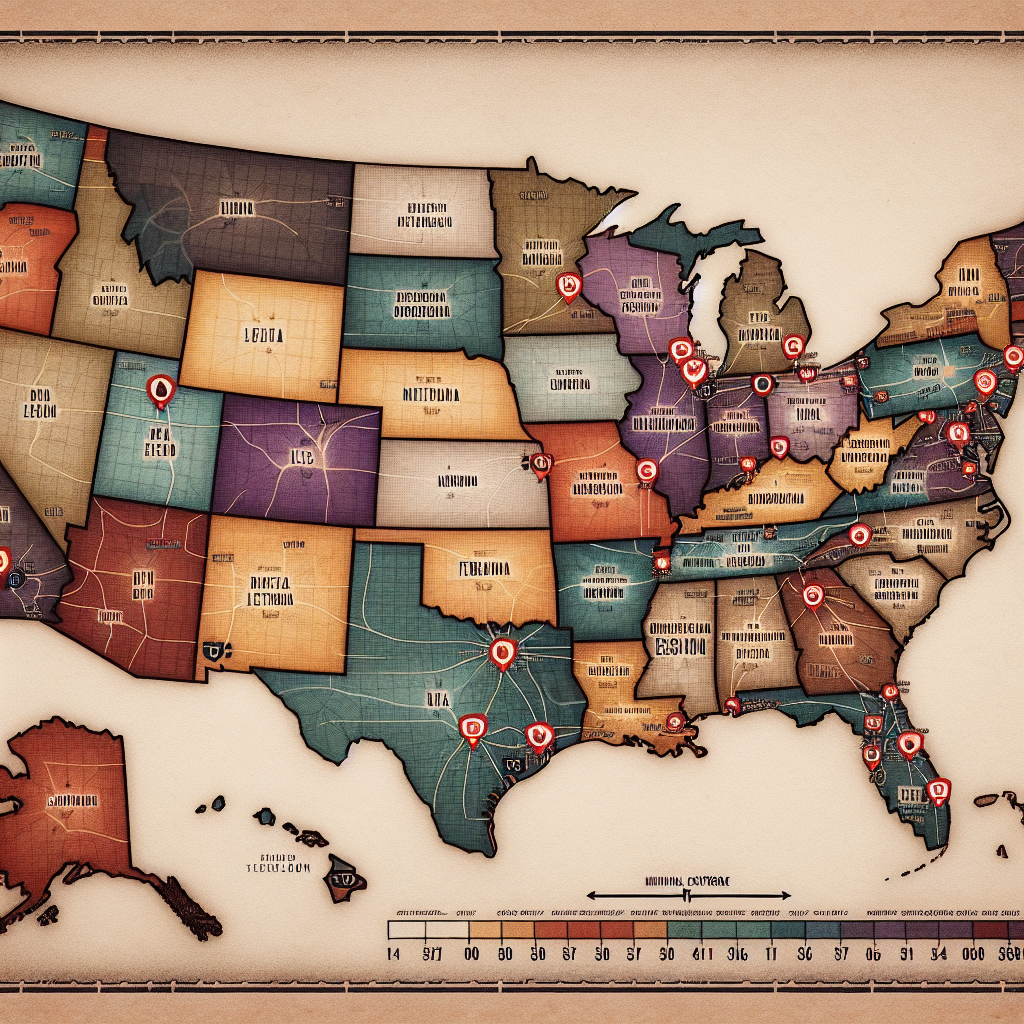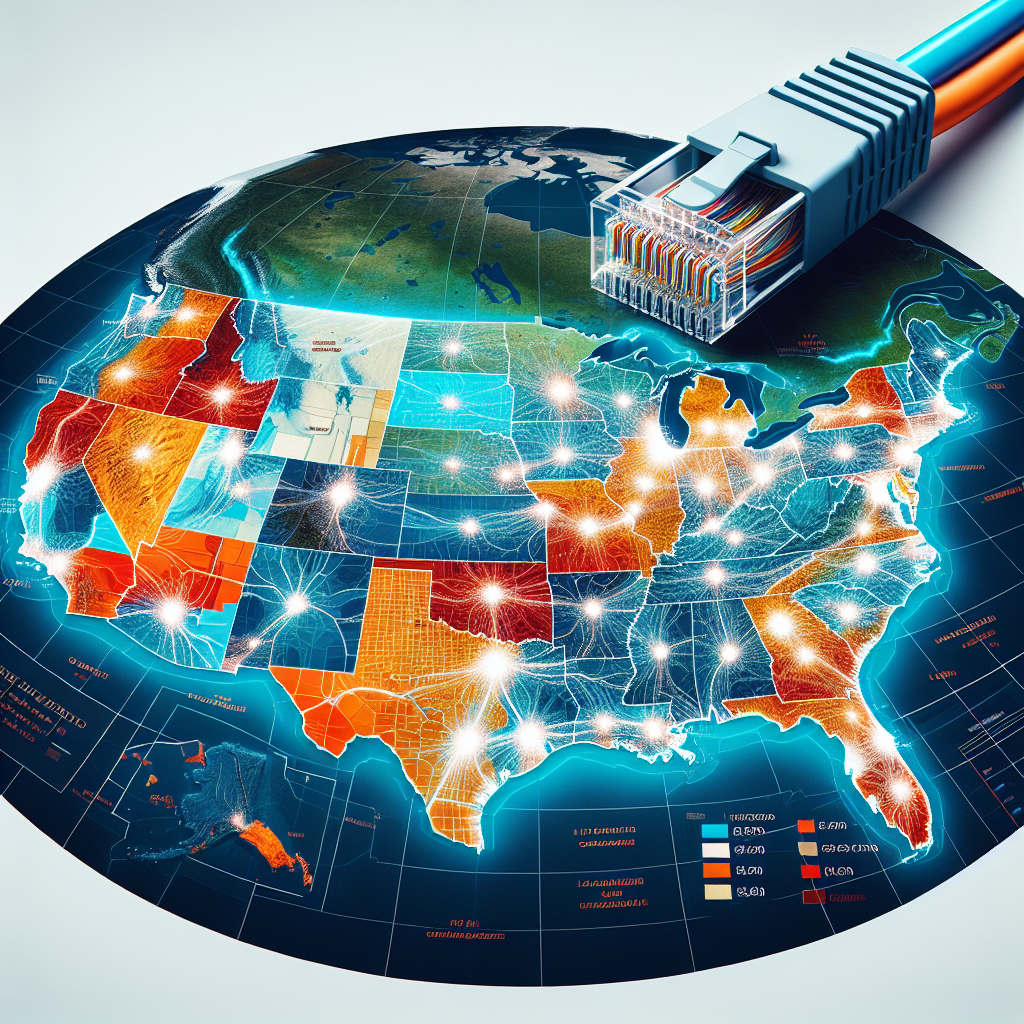Welcome to the fascinating world of fiber optic internet coverage in the USA! In this ever-evolving technological landscape, fiber optic internet has emerged as a game-changer, offering lightning-fast speeds and unparalleled reliability. But where exactly can you find this revolutionary service? Enter the Fiber Optic Internet Coverage Map, your ultimate guide to pinpointing the locations across the United States where fiber optic internet is available. From bustling urban centers to remote rural areas, this map will show you the path to blazing-fast connectivity. Say goodbye to lag and buffering, and hello to a world of seamless online experiences with fiber optic internet coverage in the USA.
Understanding Fiber Optic Internet
Fiber optic internet is a type of internet connection that utilizes fiber optic cables to transmit data. These cables are made of thin strands of glass or plastic that are designed to carry digital information over long distances at the speed of light. Unlike traditional broadband connections that use copper wires, fiber optic internet offers significantly faster speeds and higher bandwidth capabilities.
What is fiber optic internet?
- Fiber optic internet is a high-speed internet connection that uses fiber optic cables to transmit data.
- These cables are made of glass or plastic strands that carry digital information through pulses of light.
How does fiber optic internet differ from traditional broadband?
- Fiber optic internet offers faster speeds and higher bandwidth capabilities compared to traditional broadband connections.
- The use of light to transmit data in fiber optic cables results in lower latency and better reliability.
- Traditional broadband connections, such as DSL or cable, rely on copper wires which limit the speed and bandwidth potential.
Importance of Fiber Optic Internet Coverage

In the digital age, fiber optic internet has become a critical component of modern communication infrastructure. Its importance lies in its ability to transmit data at incredibly high speeds over long distances, making it ideal for supporting the growing demand for bandwidth-intensive applications and services.
Understanding the benefits and importance of fiber optic internet, such as high speeds, reliability, scalability, and low latency, is crucial for realizing its potential in enhancing connectivity for businesses and communities. Additionally, bridging the digital divide and ensuring equitable access to fiber optic internet through strategic deployment, public-private partnerships, subsidized programs, community outreach, education, and inclusive policies is essential for fostering widespread adoption and connectivity across diverse populations.
Why is fiber optic internet crucial for modern communication?
- High Speeds: Fiber optic cables can carry data at speeds that far surpass traditional copper cables, enabling faster downloads, smoother streaming, and seamless online gaming experiences.
- Reliability: Fiber optic connections are less prone to interference and signal degradation, resulting in more stable and consistent internet performance.
- Scalability: As our reliance on the internet continues to increase, fiber optic networks offer the scalability needed to support future technological advancements and innovations.
- Latency: Fiber optic internet has lower latency compared to other types of connections, ensuring minimal delays in data transmission, crucial for real-time applications like video conferencing and online gaming.
What are the benefits of fiber optic internet over other types of connections?
- Greater Bandwidth: Fiber optic cables have a much higher bandwidth capacity than traditional copper cables, allowing for the simultaneous transmission of large amounts of data.
- Security: Fiber optic connections are more secure as they are difficult to tap into without detection, making them ideal for sensitive data transmission.
- Durability: Fiber optic cables are more durable and less susceptible to environmental factors such as electromagnetic interference or inclement weather, ensuring a more reliable internet connection.
- Future-Proof: Investing in fiber optic infrastructure ensures that communities and businesses are equipped to handle the increasing demands of technology for years to come.
Speed and Reliability
Importance of Fiber Optic Internet Coverage
Fiber optic internet is renowned for its exceptional speed and reliability, making it a top choice for consumers seeking high-performance connectivity. The speed of fiber optic internet is unparalleled, with the capability to deliver symmetrical upload and download speeds reaching up to 1 gigabit per second (Gbps) or even higher. This means that users can enjoy lightning-fast data transfers, seamless streaming of high-definition content, and lag-free online gaming experiences.
In terms of reliability, fiber optic connections outperform traditional cable and DSL connections by a significant margin. Fiber optic cables are made of glass or plastic, which are not susceptible to electromagnetic interference, signal degradation, or inclement weather conditions that often disrupt cable or DSL services. This results in a more stable internet connection with minimal latency and packet loss, ensuring a consistently smooth browsing and streaming experience for users across the network.
Bandwidth and Scalability
Explain the concept of bandwidth in fiber optic internet:
Bandwidth in fiber optic internet refers to the capacity or the amount of data that can be transmitted over the network in a given period. Unlike traditional copper wires, fiber optic cables can support much higher bandwidths due to the way light signals travel through them. This allows for faster and more reliable data transmission.
How does fiber optic internet support scalability for future needs?
Fiber optic internet offers superior scalability compared to other types of internet connections. As technology advances and data requirements grow, fiber optic networks have the ability to easily accommodate increased demands. This scalability is achieved by the immense capacity of fiber optic cables to handle higher data rates without significant infrastructure upgrades. Consequently, fiber optic internet is well-equipped to meet the evolving needs of consumers and businesses in the future.

Mapping Fiber Optic Internet Coverage in the USA
Fiber optic internet coverage in the USA varies significantly based on geographical location and population density. Several key factors influence the distribution and expansion of fiber optic networks across the country:
- Urban vs. Rural Disparities
- Major cities and urban areas tend to have more extensive fiber optic coverage compared to rural regions. Companies often prioritize high-density areas due to cost efficiency and higher potential customer base.
-
Rural areas face challenges in fiber optic network expansion, primarily due to the high costs associated with laying down infrastructure over long distances with fewer potential subscribers.
-
State-Level Variances
- States like California, New York, and Texas have more robust fiber optic coverage due to their large populations and higher demand for high-speed internet services.
-
On the other hand, states in the Midwest and parts of the South may have limited fiber optic coverage, especially in remote or less populated areas.
-
Competition among Internet Service Providers (ISPs)
- The presence of multiple ISPs in a region often leads to more extensive fiber optic coverage as companies strive to outdo each other in providing high-speed internet services.
-
In areas where a single ISP dominates the market, fiber optic coverage may be limited, as there is less incentive for the provider to invest in infrastructure upgrades.
-
Government Initiatives and Regulations
- Government initiatives at the federal, state, and local levels play a crucial role in promoting the expansion of fiber optic networks. Funding programs and regulatory measures can incentivize ISPs to extend their coverage to underserved areas.
- Regulations related to right-of-way access, zoning laws, and permitting processes can either facilitate or hinder the deployment of fiber optic infrastructure, impacting coverage across different regions.
Key Players in Fiber Optic Internet Expansion
Mapping Fiber Optic Internet Coverage in the USA
- Major Companies Investing in Fiber Optic Infrastructure:
- Companies such as Verizon, AT&T, and Google Fiber have been at the forefront of expanding fiber optic internet coverage in the USA.
- Verizon, through its Fios service, has been deploying fiber-to-the-home networks in various states, offering high-speed internet connections.
- AT&T has also invested significantly in expanding its fiber optic network, known as AT&T Fiber, to provide faster and more reliable internet services to residential and business customers.
-
Google Fiber, although available in limited cities, has been a disruptive force in the industry, pushing for greater access to high-speed internet through fiber optic technology.
-
Government Initiatives Promoting Fiber Optic Internet Coverage:
- The Federal Communications Commission (FCC) has been involved in promoting broadband expansion, including fiber optic networks, through initiatives like the Connect America Fund.
- State governments have also played a role in incentivizing companies to invest in fiber optic infrastructure through grants, tax breaks, and other forms of support.
- Public-private partnerships have emerged as a common approach to expanding fiber optic internet coverage, with governments working alongside telecom companies to bridge the digital divide and improve connectivity in underserved areas.
Regional Disparities in Coverage
The discrepancies in fiber optic internet coverage across the United States are stark, particularly when comparing urban and rural areas.
– Urban Areas: Cities and densely populated regions often boast extensive fiber optic infrastructure, providing high-speed internet access to a large percentage of the population. Companies tend to prioritize urban areas due to the higher concentration of potential customers and the lower cost of deployment.
– Rural Areas: In contrast, rural areas face significant challenges in accessing fiber optic internet. The cost of laying fiber optic cables over long distances with low population density makes it financially unfeasible for many internet service providers to expand their networks to these underserved regions.
Exploring the challenges faced in expanding fiber optic networks to underserved regions reveals a complex landscape of obstacles.
– Cost: The primary barrier to extending fiber optic coverage to rural areas is the prohibitive cost. Building the necessary infrastructure in remote locations can require substantial investment, without the guarantee of a significant return on that investment in the short term.
– Regulatory Hurdles: Regulatory requirements and permitting processes can further complicate the expansion of fiber optic networks. Navigating local regulations and gaining approval for construction projects in different jurisdictions can delay or deter companies from undertaking such initiatives.
– Technological Limitations: In some cases, the topography of rural areas presents technological challenges to laying fiber optic cables. Terrain, environmental factors, and existing infrastructure can all impact the feasibility and effectiveness of expanding fiber optic internet coverage in these regions.
Understanding these regional disparities in fiber optic internet coverage is crucial for policymakers, internet service providers, and communities seeking to bridge the digital divide and ensure equitable access to high-speed internet across the country.
Leveraging Fiber Optic Internet for Enhanced Connectivity
Fiber optic internet has revolutionized the way businesses operate in the modern digital landscape. Its unparalleled speed and reliability have opened up a world of possibilities for organizations looking to enhance their connectivity capabilities. Here are some key ways in which businesses can benefit from fiber optic internet connectivity:
-
Increased Bandwidth: Fiber optic internet offers significantly higher bandwidth compared to traditional copper cables. This allows businesses to transmit large amounts of data at lightning-fast speeds, enabling seamless communication and collaboration.
-
Enhanced Reliability: Unlike copper cables, fiber optic cables are not susceptible to electromagnetic interference or inclement weather conditions. This means businesses can enjoy a more stable internet connection, minimizing downtime and ensuring consistent productivity.
-
Scalability: Fiber optic internet is highly scalable, making it ideal for businesses of all sizes. Whether a small startup or a large corporation, organizations can easily upgrade their internet connection to meet growing demands without compromising on performance.
-
Improved Security: Fiber optic cables are inherently more secure than traditional copper cables, as they are difficult to tap into without detection. This enhanced security feature is particularly beneficial for businesses handling sensitive data and confidential information.
In addition to these advantages for businesses, the impact of fiber optic internet on telecommunication services and technological advancements is profound. The widespread adoption of fiber optic technology has paved the way for innovations in areas such as telemedicine, virtual reality, and Internet of Things (IoT) devices. As more regions across the USA gain access to fiber optic internet coverage, the potential for transformative advancements in various industries continues to grow.
Future Prospects of Fiber Optic Internet
- Predictions for the growth and evolution of fiber optic internet technology:
Fiber optic internet technology is poised for significant growth and evolution in the coming years. Industry experts forecast a substantial increase in the deployment of fiber optic networks across the USA to meet the escalating demand for high-speed internet connectivity. With the increasing reliance on digital technologies and data-intensive applications, fiber optic internet is expected to play a crucial role in enhancing network performance and reliability. The ongoing advancements in fiber optic technology, such as improved data transmission speeds and enhanced bandwidth capacity, will further drive the adoption of fiber optic internet services nationwide.
- Potential innovations in fiber optic internet infrastructure and services:

The future of fiber optic internet holds promising innovations in infrastructure and services that will revolutionize the digital landscape. One of the key areas of development is the expansion of fiber optic networks to underserved and rural regions, bridging the digital divide and providing equitable access to high-speed internet services. Additionally, advancements in fiber optic cable technology, such as increased flexibility and durability, will enable more efficient deployment of fiber networks in various environments. Moreover, the integration of fiber optic internet with emerging technologies like 5G networks and Internet of Things (IoT) devices is expected to create new opportunities for enhanced connectivity and seamless digital experiences.
Ensuring Equitable Access to Fiber Optic Internet
In the quest to bridge the digital divide, ensuring equitable access to fiber optic internet is paramount. The disparity in internet access across different regions and demographics highlights the need for targeted efforts to expand fiber optic coverage nationwide.
Addressing the Digital Divide through Equitable Distribution
-
Strategic Deployment: Prioritizing the installation of fiber optic infrastructure in underserved areas is crucial to narrowing the digital gap. By focusing on regions with limited internet access, providers can significantly enhance connectivity for communities that have been historically marginalized.
-
Public-Private Partnerships: Collaborations between government entities, private companies, and nonprofit organizations can facilitate the expansion of fiber optic networks to areas where commercial viability may be limited. Leveraging combined resources and expertise can accelerate the deployment of high-speed internet services to underserved populations.
-
Subsidized Programs: Implementing subsidy programs for low-income households and rural communities can make fiber optic internet more affordable and accessible. By offering financial assistance or discounts on service plans, more individuals and families can benefit from the advantages of reliable and fast internet connectivity.
Strategies to Bridge the Gap in Fiber Optic Internet Access Among Diverse Communities
-
Community Outreach: Engaging with local communities to understand their specific needs and challenges related to internet access is essential for developing targeted solutions. Hosting outreach events, conducting surveys, and collaborating with community leaders can help tailor fiber optic deployment strategies to meet the diverse requirements of different population groups.
-
Education and Training: Providing digital literacy programs and technical training to residents in underserved areas can empower individuals to fully utilize fiber optic internet services. By equipping people with the necessary skills and knowledge, barriers to adoption can be overcome, leading to increased usage and engagement with high-speed internet technologies.
-
Inclusive Policies: Advocating for policies that promote inclusivity and diversity in fiber optic internet deployment is key to ensuring equitable access for all. By advocating for regulatory frameworks that prioritize equal opportunities for connectivity, stakeholders can work towards a more inclusive and accessible digital landscape for everyone.
FAQs – Fiber Optic Internet Coverage Map in the USA
Can I check if fiber optic internet is available in my area using a coverage map?
Yes, you can check the availability of fiber optic internet in your area using a fiber optic internet coverage map. Many internet service providers offer online tools or maps on their websites where you can input your address to see if fiber optic internet is available at your location.
How accurate are fiber optic internet coverage maps?
Fiber optic internet coverage maps are typically accurate as they are based on data provided by internet service providers. However, there may be cases where the map is not entirely up-to-date or there are limitations to the coverage in certain areas. It’s always best to check with the service provider directly for the most current information on fiber optic internet availability.
Are there any websites that offer a comprehensive fiber optic internet coverage map for the USA?
Yes, there are websites that offer comprehensive fiber optic internet coverage maps for the USA. Some popular websites include FiberLocator, BroadbandNow, and Ookla’s Fiber Map. These websites provide detailed information on fiber optic internet availability from multiple service providers across the country.
Can I rely solely on a fiber optic internet coverage map to choose an internet service provider?
While a fiber optic internet coverage map can be a helpful tool in narrowing down your options, it’s important to not rely solely on the map when choosing an internet service provider. Factors such as pricing, customer reviews, and customer service should also be taken into consideration when selecting a provider. It’s recommended to research multiple providers and compare their offerings before making a decision.